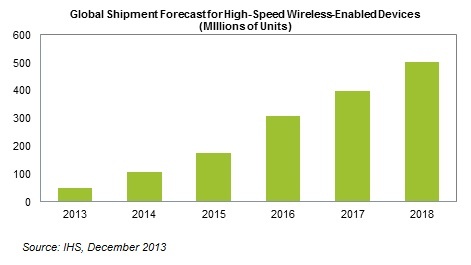The global market for high-speed wireless-enabled devices is set for explosive growth within the next five years as more consumer electronics products take advantage of rapid wireless transfer capabilities, according to a new report from IHS Inc. (http://www.isuppli.com).
Annual shipments of high-speed wireless-enabled devices such as smartphones, televisions and mobile PCs are expected to reach 503 million devices by 2018, up more than tenfold from 49 million units anticipated in 2013, says the research group. Growth during the next three years will be tremendous, ranging from 60% to 120%, with expansion during the last two years of the forecast window moderating somewhat to still-high increases of up to 30%, as shown in the attached figure.
A high-speed wireless-enabled device, as defined by IHS, is one that includes at least one of the following technologies: WirelessHD, WHDI, 802.11ad (WiGig) or multi-stream Wi-Fi (802.11n 3×3 higher or 802.11ac 2×2 and higher). These technologies, in turn, are known for featuring wireless speeds several times faster than that of 802.11n and earlier, which offer velocities anywhere between 72 megabits per second (mbps) to 530 mbps typical of Wi-Fi.
“Much of the anticipated growth in the high-speed wireless industry will be attributed to the increase of both WiGig and multistream Wi-Fi in mobile and home entertainment applications by the end of the forecast period,” says Stephanie Gibbons, senior analyst for connectivity at IHS. “In particular, WiGig and multistream Wi-Fi are the two technologies set to drive high-speed wireless adoption into key consumer electronics applications.”
The top three revenue opportunities for suppliers of high-speed wireless integrated circuits will be smartphones, TVs and mobile PCs, Gibbons noted. By 2018, some 1.7 billion high-speed wireless ICs will ship cumulatively into these three and various other applications.
Also in 2018, some 537 million high-speed wireless modules are expected to ship, almost 60% of which will consist of multistream Wi-Fi modules. Routers and set-top boxes will represent the largest applications for multi-stream Wi-Fi, says iHS. Among the various high-speed wireless technologies, WHDI is projected to move away from traditional consumer electronics uses toward more niche applications, such as high-end video production and real-time streaming of high-definition content.
For its part, the current use cases for 60-GHz WiGig technology are wireless docking, which pushes video from a WiGig-enabled PC to a wireless display. WiGig is expected to go into mobile devices by the end of 2015, which will drive increased shipments of WiGig chips, iHS says.


